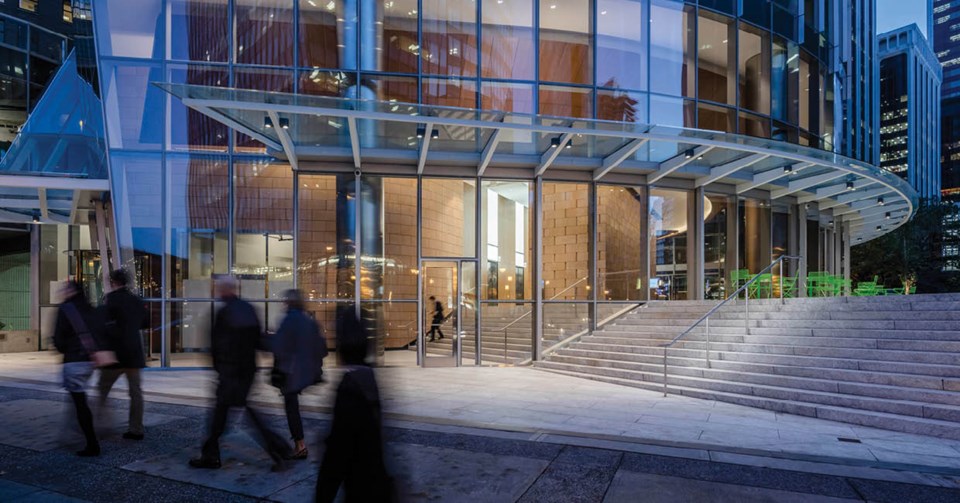People need to be at the centre of landlord efforts to lease up space, panellists told commercial real estate association NAIOP in Vancouver on Oct. 26.
Stubbornly high vacancies that average 11.8 per cent in downtown Vancouver have been driven by economic pressures, putting the onus on landlords to reconsider how to reposition space to attract workers. The available volume is equivalent to about 168 full floors of space.
“We’re not in the business of leasing space, we’re in the business of creating an environment where people want to come,” said Glenn Gardner, a principal with Avison Young in Vancouver, cribbing a quote from moderator Andrew Dickson, leasing director with Oxford Properties Group, to round out comments from fellow panel members.
Gardner is optimistic that the next year could see vacancies drop below current levels if landlords took the approach seriously.
Spaces where people want to come must create both a calm working environment and an activated environment for social engagement. This was the biggest demand from workers as they returned from the comforts of home, with a new-found appreciation for the sound of silence.
“The biggest surprise that we’ve seen is privacy, and acoustical privacy,” said Janay Koldingnes, founder of Edit Studios, an interior design consultancy in Vancouver. “So many people were saying I don’t want to be in an open work environment, I don’t want to be disrupted, I want quiet, heads-down space.”
When one of her clients surveyed its staff to see what their ideal workspace was, the image came back of a 1980s-style cubicle, bucking the whole notion of collaborative workspaces that gained momentum as co-working gained momentum prior to the pandemic.
“We’re not going to design people into government-style stations again, but we have to be more cognizant of the private spaces, the contemplative spaces,” Koldingnes said.
Reading nooks have become popular as shared spaces, which now account for much more than the 30 per cent share of floorspace they had prior to 2020.
It’s those shared spaces that facilitate the “collisions” that panellist Jarvis Rouillard, senior vice-president with PCI Developments, say are vital to the social life of workers.
“Collisions is going to be our thing,” Rouillard said. “People want to collide, not only with their colleagues but also people from other companies that are also in that building.”
This doesn’t mean that traffic cops aren’t needed, of course. While the permeable nature of public space lends vibrancy to the urban environment, buildings are closed communities – something the increase in civil disorder has underscored for building owners in major downtowns from Dublin to Dallas and north to Vancouver.
“We’re so focused on security,” Rouillard said. “We’ve had 24/7 lobby guards and things like that put into some of our buildings, which has helped, and has actually secured some tenants.”
But the average worker seldom signs the leases, and this means putting the needs of tenants up front, too.
PCI, for example, has been filing tenant improvement permit for multiple floors at a time, to ensure they’re ready for when a tenant signs a lease. This saves them time, reduces uncertainties and minimizes the interruption a move can cause.
CBRE Ltd. vice-chair Kevin Nelson, who works with technology companies, said spaces also have to measure up to a higher standard than ever before in terms of how a tenant’s workers will occupy the space.
“You literally have to check every single box that they want or they’re just not going to look at your building,” said Nelson, who was touring “a big international tenant” though local options earlier this week.”
They’re looking for conference rooms, cafés, restaurants and gyms on site so that the workplace is a destination and not just a location.
“And not just that it’s a gym, but it’s a real gym. It has the towel service, it has the showers, it’s a place where you want to go,” Nelson said. “If somebody can come in, use the gym, work for five or six hours and go home, that’s a win for a lot of employers today.”
An office block that can convey the riches within at first glance will making a winning impression on a tenant, Koldingnes added.
“The lobby is the front door to all of it,” she said, describing the MNP Tower lobby at 1021 West Hastings Street in Vancouver as an example of a lobby that’s fully activated. “That first experience sets the tone for the tenant.”




